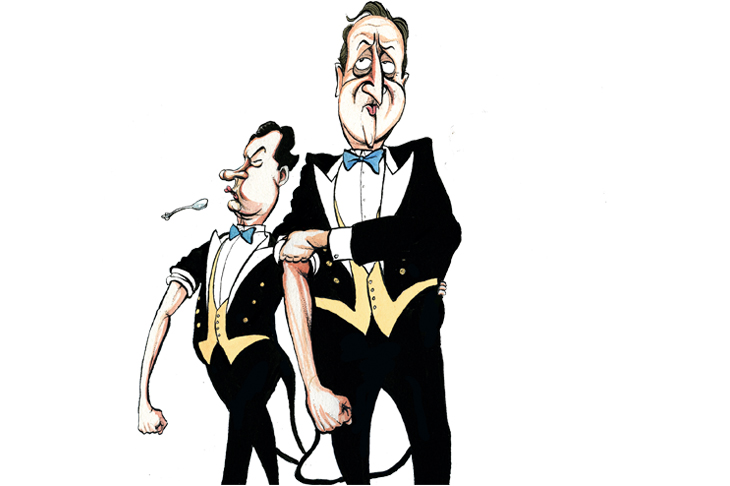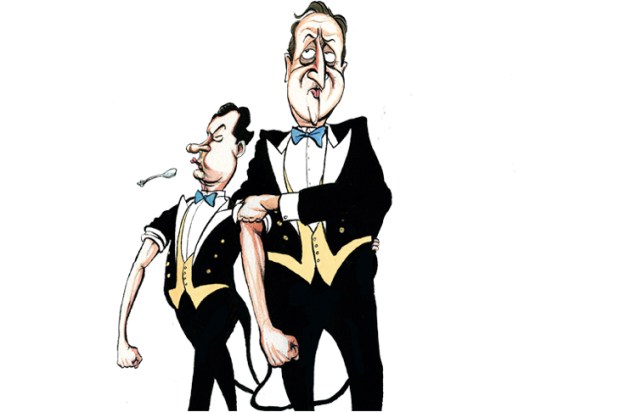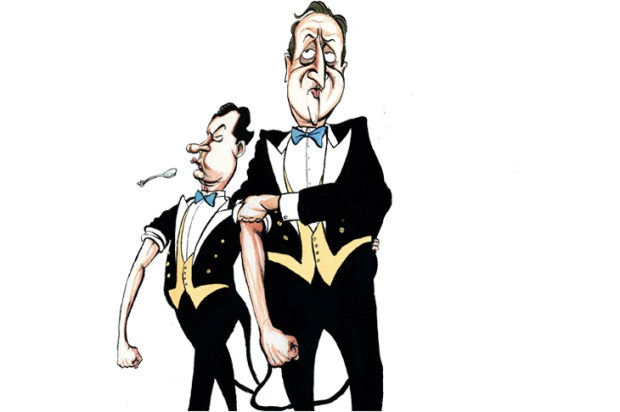RIP the Bullingdon Club, 1780–2017.
It isn’t quite dead — but it is down to its last two members. That’s barely enough people to trash each other’s bedrooms, let alone a whole restaurant, as the Bullingdon was wont to do, according to legend — not that we ever did that sort of thing in my time in the club, from 1991 to 1993.
The Bullingdon, or Buller, as it is sometimes known, just couldn’t survive 11 years of bad headlines — from 2005 to 2016, when three of its former members, David Cameron, George Osborne and Boris Johnson, were the most powerful Conservatives in the country. For more than a decade the Bullingdon exerted a totemic power so mighty that it spawned several conspiracy theories. One website, ‘Abel Danger’, claims Bullingdon members are placed ‘in positions of power and influence throughout the world and controlled and blackmailed into executing the plans of the power behind the club — the House of Rothschild’. Twenty years on, I’m still awaiting that call placing me in a position of power and influence throughout the world.
Harry Mount discusses the demise of the Bullingdon Club on the podcast:
The journalist Peter Hitchens was convinced the famous Bullingdon photo was airbrushed to edit out a high-powered member. In fact the photo, badly reproduced in a magazine, just showed the ghost of a member’s white shirt accidentally transplanted to the opposite side of the picture.
‘Remember, I saw this sort of doctoring the whole time in communist Russia,’ Hitchens told me gravely.
Before those 11 years in the limelight, the Bullingdon was rather obscure. I can understand why. The club wasn’t secret — but it was cloaked in a veil of mild embarrassment. Even at the time, I felt somewhat ashamed of having joined it.
I remember walking from my college for the annual Bullingdon photograph. I skulked along Merton Street, hugging the rough limestone wall beside the pavement, my navy blue tailcoat and English-mustard-coloured waistcoat bundled under my arm to avoid ridicule.
So the club’s virtual disappearance is no great loss but, before it goes the way of the dodo, it deserves a brief obituary.
The Bullingdon began life as a hunting and cricket club in 1780; the club badge still shows a cricket bat, stumps and a man on a horse. The Bullingdon cricket team even played against the MCC several times. In their first fixture, in 1795, the Bullingdon lost by eight wickets to the MCC at their ground on Bullingdon Green.
Until 1879, Bullingdon Green — now built over — was a cricket pitch on the south-eastern outskirts of Oxford, between Horspath and Cowley. Bullingdon Green in turn takes its name from the old Bullingdon Hundred, a chunk of Oxfordshire south-east of Oxford where the Bullingdon point-to-point used to be held.
The only other major institution to take its name from the Bullingdon Hundred is — appropriately enough, given the antics of some club members, such as the former jailbird Darius Guppy — Bullingdon Prison, a category B/C prison in Arncott, Oxfordshire. Recent inmates include Rolf Harris.
Over the centuries, the sporting interests of the club morphed into heavy drinking interests. By 1894, the heavy drinking turned to bad behaviour — Bullingdon members smashed all 468 windows in Christ Church’s Peckwater Quad.
In 1927, they did it again — leading to them being banned from meeting within 15 miles of Oxford. That incident must have inspired the opening scene of Evelyn Waugh’s Decline and Fall — published only a year later, in 1928, and due to be revived this spring in a BBC2 adaptation.
The book begins with the dons of Scone College longing for the Bollinger Club to smash up the quad, so the college can make a fortune in fines. The dons are thrilled to hear that distinctive noise, ‘the sound of the English county families baying for broken glass’.
It is Waugh’s magnificent lampoon that still defines the Bullingdon today — and, indirectly, led to the club’s own decline and fall. The Bullingdon crops up again in Brideshead Revisited (1945), where ‘cretinous, porcine’ members try to dunk Anthony Blanche in Mercury, the fountain in Christ Church’s Tom Quad.
After the war, the Bullingdon kept ticking along in a champagne-fuelled slumber, forgotten by everyone but its members. And then — like some rare, tragic flower at Kew Gardens — the club had that brief, blooming moment from 2005 to 2016, before expiring through overexposure.
There is, though, another Bullingdon Club that’s thriving. The Bullingdon Craft and Social Club, an over-sixties’ group, still meets every month in the Bullingdon Community Centre in Headington, on the outskirts of Oxford. It specialises in table tennis, darts, giant Jenga, cards, dominoes and jigsaws. No tailcoats; no heavy drinking; no broken glass.
The old Bullingdon Club is dead; long live the new one.
Got something to add? Join the discussion and comment below.
Get 10 issues for just $10
Subscribe to The Spectator Australia today for the next 10 magazine issues, plus full online access, for just $10.














Comments
Don't miss out
Join the conversation with other Spectator Australia readers. Subscribe to leave a comment.
SUBSCRIBEAlready a subscriber? Log in